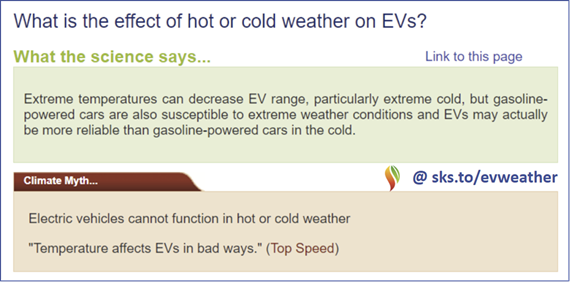Sabin 33 #33 - What is the effect of hot or cold weather on EVs?
Posted on 17 June 2025 by Ken Rice
On November 1, 2024 we announced the publication of 33 rebuttals based on the report "Rebutting 33 False Claims About Solar, Wind, and Electric Vehicles" written by Matthew Eisenson, Jacob Elkin, Andy Fitch, Matthew Ard, Kaya Sittinger & Samuel Lavine and published by the Sabin Center for Climate Change Law at Columbia Law School in 2024. Below is the blog post version of rebuttal #33 based on Sabin's report.
Extreme temperatures can decrease EV range, particularly extreme cold, but this issue is not unique to EVs. According to a 2019 American Automobile Association report, when compared to conditions of 75°F with the HVAC set to Off, a typical EV’s range decreased by 12% at 20°F, and by 4% at 95°F1. When comparing conditions with the HVAC set to Auto, a temperature drop from 72°F to 20°F decreased a typical EV’s range by 41%2, and a temperature rise from 72°F to 95°F decreased range by 17%. However, EV models are increasingly adopting heat pump technology in place of traditional electric resistance heating3, which can minimize the electricity consumption associated with heating an electric vehicle in extreme cold4.
Traditional gasoline-powered cars are likewise susceptible to extreme weather conditions. Fuel economy tests have also shown a decrease in mileage per gallon for conventional gasoline cars due to temperature drops, with mileage roughly 15% lower at 20°F than at 72°F5. As with EVs, decreased fuel efficiency for conventional gasoline cars in extreme weather is partially attributable to increased reliance on HVAC systems. Both EVs and gasoline-powered cars are likewise susceptible to cold temperatures lowering tire pressure6.
Data from a roadside assistance company in Norway suggests that, by one metric, EVs may actually be more reliable than gasoline-powered cars in the cold7. In particular, whereas internal combustion engines sometimes have trouble starting in the cold, this problem appears to be less common for EVs: while 23% of cars in Norway are EVs, only 13% of reported cases involving cars that failed to turn on in the cold were EVs8.
Footnotes:
[1] Federico Alcala, 15 Disadvantages of Electric Cars, TopSpeed (Jul. 6, 2023).
[2] AAA Electric Vehicle Range Testing, American Automobile Association, 32, 51 (2019).
[3] Carolyn Fortuna, Why Heat Pumps Are Essential for EVs When the Weather Is Cold, CleanTechnica, Jan. 22, 2024
[4] Shannon Osaka, Why you might want a heat pump in your electric car, Washington Post, Jan 7 2023.
[5] Fuel Economy in Cold Weather, US Dep't Energy (last visited March 25, 2024).
[6] Sydnie Gjerald, Winter Range: ICE vs EV, UTILMARC, Jan. 4 2022.
[7] Fred Lambert, Electric vehicles fail at a lower rate than gas cars in extreme cold, ELECTREK, Jan. 17, 2024.
[8] Emily Schmall & Jenny Gross, Electric Car Owners Confront a Harsh Foe: Cold Weather, N.Y. TIMES, Jan. 17, 2024.
Skeptical Science sincerely appreciates Sabin Center's generosity in collaborating with us to make this information available as widely as possible.![]()































 Arguments
Arguments































We've owned a Tesla for 8 years. We live in Minnesota where it can get down to -20F or colder. We have a car with a resistance heater, but even if we had a heat pump, at -20F it isn't going to do much.
EVs suffer from reduced range in extreme cold and heat pumps don't help this situation very much. If you live in Minnesota and need your car to drive to work, you have to be able to rely on it to do that on the coldest days you may experience. EVs with modest sized batteries are good for at least 100 miles on the coldest days in Minnesota, and this is usually more than enough for the daily commute cycle.
The up side is that our EV is much more reliable in the extreme cold than any other vehicle we've owned. There are pluses and minuses to everything, and I will gladly trade range for reliability, because I can manage with a 100 mile range more readily than I manage with a car that may not start.
I used to live in the Canadian prairies (north-west of Evan's Minnesaota location, and I can attest to the problems that extreme cold can have on ICE-powered vehicles. (We saw lows as cold as -40C ...or -40F, if you prefer...)
At such cold temperatures, oil does not flow easily, batteries lose power, and engines often do not want to start. A standard "optional" extra was a block heater: an electric heating element inserted in the engine block, which would be plugged into a standard 120V electrical outlet when the car was parked. Building electrical codes required that each parking spot in a residential garage be equipped with an outlet for a block heater, on its own circuit. When away from home (e.g., at work), finding parking with an electrical outlet for your block heater was an added bonus. Or even at home, if you rented an apartment and parked outside.
At colder temperatures, air is more dense, which increases air resistance regardless of the source of propulsion. This reduces energy efficiency (mileage) for all vehicles. We have not had our BEV long enough to see summer-winter differences (and we don't see the same extreme cold where we live now), but when I lived in colder climates a 20% drop in efficiency in winter was not unusual.